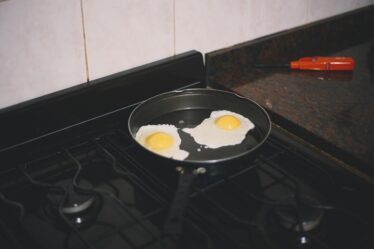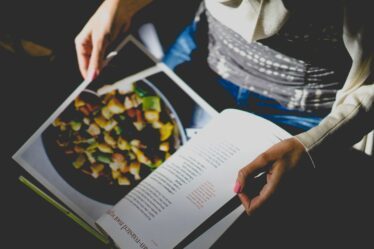
Background and Significant Details
A thoughtfully crafted lobster risotto with mushrooms transforms a home-cooked meal into an event. The mushrooms add a layer of depth, their umami flavor complementing the buttery, melt-in-your-mouth lobster. This is not simply a dish, but a testament to the art of cooking, where patience and attention to detail pay off in every luscious spoonful. For those unacquainted with culinary ventures, replicating restaurant-quality meals like this at home might seem intimidating, but the journey is richly rewarding and the process itself becomes a part of the enjoyment.
Lobster risotto seamlessly fits into various celebratory settings—from intimate date nights that call for a touch of elegance, to cozy family gatherings where every detail contributes to a memorable evening. The essence of this dish lies in its ability to make anyone feel special and pampered, from its creamy texture to the aromatic notes wafting from the pan.
The careful nature of preparing risotto ensures that each ingredient shines. Arborio rice, renowned for its high starch content, is paramount for achieving the creamy texture quintessential to risotto. The mushrooms, with their earthy profiles, are sautéed until tender, intertwining with the rice to form a delightful base. The incorporation of finely chopped shallots and minced garlic provides a fragrant foundation, creating a sensory chorus that sings with each stir of the pot.
Incorporating the lobster into the risotto requires a careful touch. The lobster meat, cooked to perfection, adds a delicate sweetness that contrasts beautifully with the risotto's creamy base. The final flourish of grated Parmesan cheese and a garnish of fresh parsley not only enhances the flavor but also adds an appealing visual element, making the dish as pleasing to the eye as it is to the palate.
This lobster risotto with mushrooms is more than a meal; it is a culinary symphony of flavors and textures, perfectly suited for those moments when you wish to create an unforgettable experience. Whether served in the intimacy of a candle-lit dinner for two or as the highlight of a festive family gathering, it captivates and delights, ensuring that the occasion is remembered long after the last bite.
Crucial Ingredients Explanation
Arborio Rice: The foundation of any great risotto, Arborio rice is indispensable due to its high starch content, which is essential for the creamy texture. The grains' ability to absorb liquid while releasing starch ensures a velvety consistency that is the hallmark of an excellent risotto.
Lobster Meat: This ingredient represents the pinnacle of luxury and flavor. The sweet, succulent lobster adds a touch of sophistication and decadence, transforming the dish from a simple risotto into an extraordinary culinary creation. Its delicate taste and tender texture complement the creaminess of the rice wonderfully.
Mushrooms: With their earthy and umami-rich profile, mushrooms deepen the flavor profile of the risotto, adding intricacy and a savory richness. They provide a robust counterpoint to the sweet lobster, ensuring that each bite is layered with interesting contrasts.
Dry White Wine: Used during the initial stages of cooking the rice, dry white wine adds necessary acidity that balances the richness of the dish. It also contributes a nuanced depth of flavor that elevates the overall taste.
Broth: The broth is prepared by simmering lobster shells, which extracts a subtle yet profound lobster essence. This homemade broth surpasses any store-bought alternatives in delivering a pure, delicately flavored base that enriches every grain of rice.
Garlic: Fresh garlic provides aromatic undertones, enhancing the overall flavor profile without overpowering the dish. Its mild pungency brings forth a pleasant depth, ensuring a well-rounded savoriness.
Shallots: More subtle and sweeter than onions, shallots offer a refined backdrop to the dish. They gently perfume the risotto and blend seamlessly with the other ingredients, providing a sophisticated layer of flavor.
Parmesan Cheese: Freshly grated Parmesan is crucial for adding umami and a slight nutty undertone. It melds into the risotto, contributing to the luscious creaminess and enriching the overall taste with its distinctive character.
Butter: This ingredient is key to achieving the risotto's trademark smoothness. Butter imparts a silky texture and enhances the overall richness, making each spoonful irresistibly luscious.
Parsley: Freshly chopped parsley is the finishing touch that brightens the dish, adding a pop of color and a hint of herbal freshness. This garnish balances the richness of the risotto and provides a crisp, clean finish to the palate.
Cooking Tips and Techniques
To create the perfect lobster risotto with mushrooms, attention to technique is paramount. Here are essential tips to ensure your dish reaches its full potential.
Butter Poaching Lobster:
Maintain the correct temperature when butter poaching lobster, keeping it between 160°F-180°F. Use a thermometer to avoid the butter separating or browning, which can impact the texture and flavor of the lobster. Add a bit of water to the butter to stabilize it and prevent separation. Cook the lobster meat slowly and gently to maintain its tender and delicate texture. Overcooking results in tough, chewy lobster, which is not ideal.
Toasting Rice:
Toasting rice is a crucial step in making risotto. When adding the Arborio rice to the pan, toast it until the edges become translucent but the center remains opaque, usually taking about 2-3 minutes. Toasting rice ensures that each grain is coated with oil, which helps it absorb liquid more evenly, creating a creamy texture without becoming mushy.
Simmering Broth:
The broth used in risotto should simmer rather than boil. A gentle simmer keeps the broth at a consistent temperature, allowing the rice to absorb it without cooking too quickly. Boiling the broth can cause it to evaporate too fast and lead to uneven cooking.
Constant Stirring and Gradual Addition of Broth:
Stirring risotto is a balancing act. Constantly stirring is unnecessary and can make the rice gluey, but consistent and regular stirring is critical to prevent the rice from sticking to the pan and to ensure even cooking. Add the broth gradually, one ladle at a time. Wait for the previous addition to be mostly absorbed before adding more. This step helps coax the starch from the rice, creating the creamy consistency risotto is known for.
Texture Cues:
Knowing the right texture cues is essential for perfect risotto. The rice should be al dente, meaning it still has a slight firmness when bitten. The consistency should be creamy and lush, not watery or overly thick. If the rice is too hard, keep adding broth and cooking until the desired texture is achieved.
Handling Lobster Meat:
Using fresh versus frozen lobster has some considerations. Fresh lobster provides optimal flavor, but frozen lobster tails can be convenient. Thaw frozen lobster tails in the refrigerator overnight. Pat them dry with a paper towel to remove excess moisture before poaching. Properly cracking and removing the meat from the shell is also crucial. Cut along the top and bottom of the tail, crack it open gently, and remove the meat without tearing it.
Timing and Sequencing of Ingredients:
Timing in risotto preparation is everything. Start by poaching the lobster first and then proceed to make the broth. While the broth is simmering, sauté the garlic and shallots in the lobster butter, ensuring they are tender and fragrant before adding the rice. Toast the rice before deglazing with wine, and follow with the gradual addition of broth. Adding the mushrooms partway through cooking preserves their texture and flavor. Incorporate the cooked lobster and Parmesan cheese towards the end, ensuring they are warmed through, but not overcooked or melted into the dish.
By following these tips and techniques, your lobster risotto with mushrooms will embody the elegance and richness this dish deserves.
Butter Poached Lobster
Butter poaching lobster is an art that transforms a luxurious ingredient into an extraordinarily tender and flavorful component. Follow these detailed steps to achieve perfectly poached lobster meat that enhances your lobster risotto.
Begin by preparing the lobster. If using live lobsters, dispatch them humanely before removing the meat from the shell. For those using lobster tails, cut along the top and bottom of the shell with kitchen shears to crack it open. Carefully remove the meat to keep it intact. Pat the lobster meat dry with a paper towel to remove any excess moisture.
Use a medium-sized saucepan for the butter poaching process. Add a whole stick of butter and a tablespoon of water to the pan. This stabilizes the butter and reduces the risk of it separating during poaching. Add finely chopped parsley for an aromatic touch. Set the heat to low and closely monitor the temperature using a kitchen thermometer. The target range for poaching is 160°F-180°F. Keeping the butter at this temperature is crucial; exceeding 180°F can cause the butter to break and turn brown, impacting the texture and flavor.
Once the butter reaches the appropriate temperature, add the lobster meat. Ensure it is fully submerged for an even cook. If the pieces are not entirely covered, rotate them gently every few minutes. The timing is important: if the lobster is submerged, it usually takes 6-7 minutes to cook. If you need to cook the meat on each side, allow 2-3 minutes per side. The lobster should reach a pearly, opaque appearance when properly cooked.
Test for doneness by gently pressing the thickest part of the meat; it should feel firm but not rubbery. Carefully remove the poached lobster meat from the butter and set it aside to cool slightly before rough chopping.
Save the remaining poaching butter. This flavorful butter, infused with the essence of lobster and herbs, will be used later to enhance the richness of the risotto. This step ensures that the lobster's depth of flavor is not only in the meat but also seamlessly integrates into the risotto.
By following these steps, your butter-poached lobster will achieve the perfect texture and flavor, making your lobster risotto an extraordinary dish.
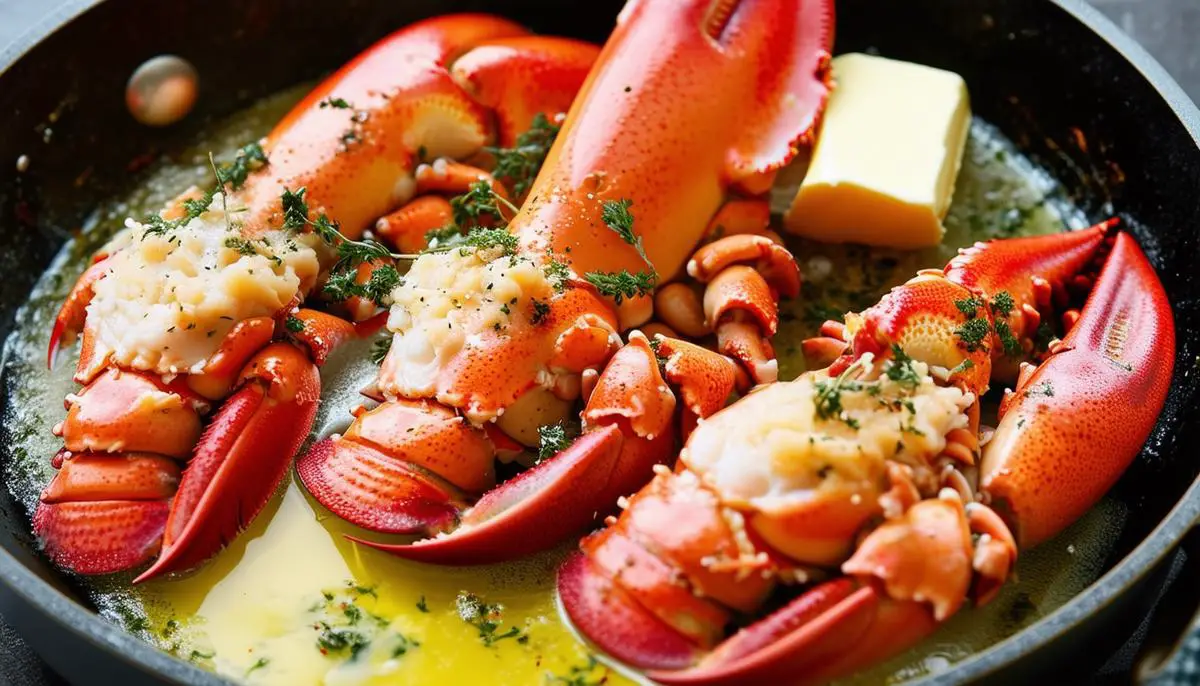
Making the Broth
Creating the broth is a crucial step that forms the backbone of your lobster risotto, imparting a delicate yet profound flavor to the dish. Start by utilizing the shells from the lobster tails you've just prepared. This method not only maximizes flavor extraction but also contributes to a sustainable and resourceful cooking practice.
Begin the broth-making process as soon as you have removed the meat from the lobster tails. Place the lobster shells in a medium saucepan, then add 2 cups of chicken or vegetable broth and 2 1/2 cups of water. Chicken broth provides a subtle depth, while vegetable broth offers a lighter alternative. Bring the mixture to a gentle simmer on medium heat. This simmering should be maintained, rather than boiling, to ensure a gradual and thorough infusion of flavors.
Cover the saucepan with a lid to trap the steam and allow the shells to impart their essence into the liquid. The recommended simmering time is about 15 minutes. This duration is sufficient for the shells to release their flavors without becoming overly fishy, ensuring the broth remains delicate yet distinctly lobster-infused. Avoid extended simmering as it can result in a more intense and less balanced flavor profile.
Once the simmering time is up, strain the broth through a fine-mesh sieve into a clean container, discarding the shells. This step ensures a smooth, clear broth without any shell fragments, ready to be gradually added to your risotto. By following this method, you capture the pure, nuanced essence of the lobster, enhancing the overall quality and taste of your risotto.
Preparing the Risotto Base
Heat 4 tablespoons of the lobster-infused butter in a wide pot over low heat. Sauté the minced garlic and finely chopped shallots for 2-3 minutes until soft and fragrant, without browning. Add the Arborio rice, stirring to coat each grain with butter. Toast the rice for 3-4 minutes until the edges become slightly translucent while the centers remain opaque. This process helps the rice absorb liquid evenly, contributing to the creamy texture.
Deglaze the pan with dry white wine, stirring until the liquid has mostly evaporated, about 2-3 minutes. The rice will start to absorb the wine, adding complexity to the flavor profile.
Gradually add the prepared broth one ladle at a time, just enough to cover the rice. Stir gently and frequently to prevent sticking. Wait for the liquid to be mostly absorbed before adding the next ladle. This process takes around 18-20 minutes, requiring attentive stirring to achieve the desired creamy consistency.
Monitor the texture of the rice throughout cooking. It should soften and absorb the broth, creating a creamy mixture without becoming mushy. The rice should ultimately reach an al dente texture, slightly firm to the bite.
By carefully following these steps, your lobster risotto base will achieve the perfect balance of creaminess and texture, setting the stage for the luxurious ingredients that elevate the dish.
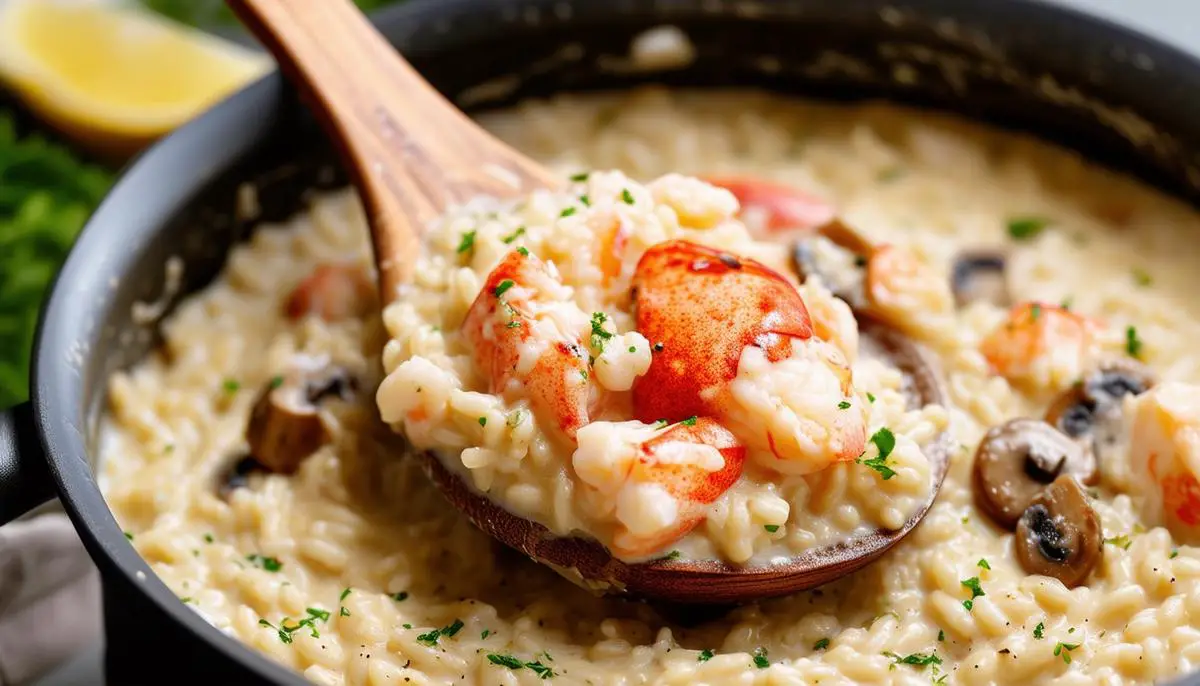
Incorporating Final Ingredients
As the rice approaches its final stages, timing the addition of the final ingredients is crucial to ensure all components meld seamlessly. Once the risotto has absorbed almost all the broth and reached a creamy consistency, while still retaining a slightly loose texture, gently fold in the chopped lobster meat. Be careful not to overcook the lobster, keeping its tenderness intact.
Sprinkle freshly grated Parmesan cheese evenly over the risotto and stir gently. The cheese will melt quickly, adding a nutty richness and enhancing the dish's umami profile.
Add the remaining lobster butter to the pan, imbued with lobster's essence, to further enrich the risotto. Stir carefully to ensure a smooth, velvety finish.
Taste the risotto for seasoning, texture, and flavor balance. The rice should be al dente, offering a slight resistance when bitten into, without being hard. Adjust the seasoning with salt and pepper as needed.
Stir the risotto a few more times to blend all the elements harmoniously, ensuring each bite delivers a balanced palette of flavors.
By attentively following these steps, your lobster risotto will embody a luxurious and cohesive dining experience, perfect for any special occasion.
Storage and Reheating Tips
To properly store lobster risotto leftovers, place the risotto in a shallow, airtight container and refrigerate for no more than 2-3 days to maintain optimal taste and quality.
When reheating, add a small amount of broth to retain the creamy texture. Use a microwave-safe dish to heat in the microwave or reheat gently on the stovetop over low heat, stirring occasionally to distribute heat evenly and revive the velvety consistency. Be cautious not to overheat, as this can cause the risotto to dry out or become overly thick.
Freezing lobster risotto is not recommended, as the freezing process can significantly alter the texture, making the rice less creamy and more clumpy upon thawing. For the best results and a satisfying experience, enjoy your lobster risotto fresh within the recommended time frame.
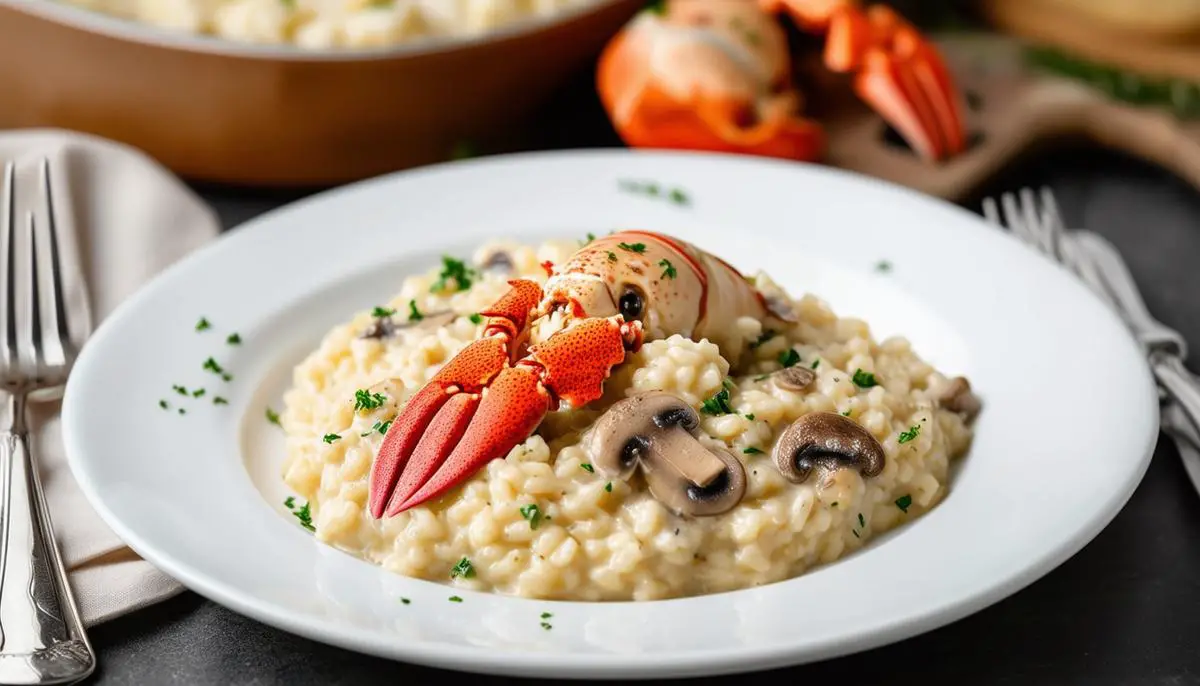
Lobster Risotto with Mushrooms Recipe
Ingredients
Lobster Poaching:
- 1 stick butter
- 1 tbsp water
- 2 tbsp parsley, minced
- 3 lobster tails (4-5 oz each)
Broth:
- 2 cups chicken or vegetable broth
- 2 1/2 cups water
- Lobster shells from poached tails
- Pinch of salt
Risotto:
- 2 tbsp olive oil
- 5 cloves garlic, minced
- 1 shallot, finely chopped
- 1 cup Arborio rice
- 3/4 cup dry white wine
- Prepared lobster broth (4-4 1/2 cups)
- Butter-poached lobster meat, chopped
- 1/3 cup Parmesan cheese, freshly grated
- 2 tbsp reserved lobster butter
- Salt and pepper to taste
- Fresh parsley for garnish, chopped
Instructions
Butter Poached Lobster
- In a medium saucepan, add the stick of butter, 1 tbsp water, and minced parsley. Heat over low, using a thermometer to maintain a temperature between 160°F-180°F.
- Cut along the top and bottom of the lobster tails with kitchen shears. Crack the shells and carefully remove the meat, keeping it intact.
- Pat the lobster meat dry. Once the butter reaches the correct temperature, add the lobster meat.
- Cook for 6-7 minutes if the lobster is fully submerged, or 2-3 minutes per side if not submerged. The lobster should be opaque and firm. Remove and set aside to cool, then rough chop. Reserve the butter for later use.
Broth
- In a medium saucepan, combine 2 cups of broth, 2 1/2 cups of water, and the lobster shells. Bring to a gentle simmer over medium heat.
- Simmer for 15 minutes with the lid on. Strain the broth and discard the shells.
Risotto Base
- In a wide pot or large pan, heat 4 tbsp of the reserved lobster butter over low heat. Add the minced garlic and shallots. Sauté for 2-3 minutes until soft and fragrant, but not browned.
- Add the Arborio rice to the pan. Stir to coat each grain with the butter. Toast the rice for 3-4 minutes until the edges become slightly translucent.
- Pour in the white wine and stir continuously until the liquid has mostly evaporated, about 2-3 minutes.
- Begin adding the prepared broth, one ladle at a time. Stir frequently and wait for the broth to be mostly absorbed before adding the next ladle. Continue this process for 18-20 minutes, until the rice reaches a creamy consistency and al dente texture.
Final Ingredients
- Once the rice has absorbed most of the broth and is creamy yet slightly loose, gently fold in the chopped lobster meat.
- Sprinkle in the Parmesan cheese and stir until it melts into the risotto.
- Add 2 more tbsp of the reserved lobster butter and stir gently to combine.
- Taste and adjust seasoning with salt and pepper as needed.
Serving
- Serve the risotto hot, garnished with freshly chopped parsley.
Enjoy your luxurious lobster risotto with mushrooms, perfect for any special occasion!
Nutritional Information (per serving):
- Calories: 610 kcal
- Carbohydrates: 52 g
- Protein: 28 g
- Fat: 31 g
- Saturated Fat: 18 g
- Cholesterol: 145 mg
- Sodium: 1120 mg
- Fiber: 2 g
- Sugar: 2 g

